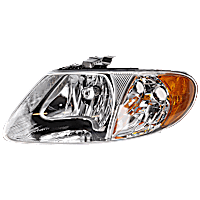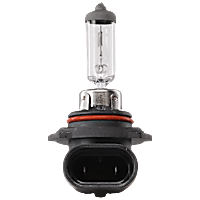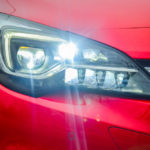Headlights help you navigate the road at night and improve visibility in bad weather. That means driving in these conditions can be dangerous if these car lights grow dim, become faulty, or stop working. On top of that, going around a faulty headlight is illegal, and you can get fined for not fixing or replacing it.
If your headlights are failing due to faulty or burnt-out bulbs, you’ll need to replace them. The first step is to identify the type of bulb your headlight has, then determine whether you want to get the same kind or go for an upgrade.
4 Types of Headlights or Headlight Bulbs
Vehicles can have halogen, LED, xenon/HID, or laser headlight bulbs. How bright, fuel-efficient, and long-lasting a car headlamp is depends on its bulb. Here’s a look at how the different kinds of headlight bulbs work and compare.

Halogen
Halogen lights contain a filament or a pair of filaments on single bulbs that provide both bright and dim headlamp functions. These bulbs have pressurized gas rather than a vacuum.
The bulb filaments are tungsten, while the glass envelope is pressurized with inert gas and a small amount of a chemically reactive halogen gas, usually iodine or bromine.
The gas allows halogen bulbs to burn brighter and longer without blackening the inside of the bulb. Some halogen bulbs have a blue coating to make them appear brighter than they are.
Most modern headlights use halogen bulbs. Some sealed beam replacements for older vehicles with glass even have halogen capsules built into the glass-sealed beam casing rather than the original type of filament.
Standard halogen headlights burn with a yellowish hue that measures at roughly 3,000 Kelvin on the color temperature scale. Some bulb manufacturers make 3,400 to 4,200 Kelvin Halogen bulbs, but those aren’t street-legal in most places.
Pros
- Doesn’t cost much to manufacture, resulting in affordable price tags
- Easy to replace on most vehicles, usually involves removing parts from the engine compartment or splash shield
Cons
- Emits a slightly yellow light
- Tends to burn hot
- Has a shorter lifespan compared to other car headlamp bulbs
Typical lifespan: 450 to 1,000 hours
Price Range: $5 to $2,500
LED
Light-emitting diode or LED headlight bulbs illuminate thanks to electroluminescence, which means electrons are fired toward positively charged holes in a semiconductor. As a result, they release energy as photons, which are particles of light.
The same technology is now prevalent on dashboard lights and screen consoles. LED lights have also been used for indicator lights on appliances, bright flashlights, as well as a growing number of vehicle stop lamps, tail lamps, interior lamps, and home lighting. In other words, LED lights are used just about everywhere these days.
LEDs can be designed to emit any color of the spectrum. They can produce a bright, white light that doesn’t blind oncoming traffic. LED lights usually range from 4,000 to 6,000 Kelvin on the color scale. Despite that, they don’t take as much energy to power compared to other bulbs.
Also, LED lights are versatile. Manufacturers can arrange and set them into different designs.
Pros
- Can illuminate up to a mile ahead
- Fuel efficient
- Runs cooler than halogen bulbs
- Could last as long as the vehicle
- Available in sleeker headlight designs
- Allows more flexibility in styling other assembly components, like turn signal lights
LED lights have also been used for indicator lights on appliances, bright flashlights, as well as a growing number of vehicle stop lamps, tail lamps, interior lamps, and home lighting. In other words LED lights are used just about everywhere these days.
–Richard McCuistian, ASE Certified Master Automobile Technician
Cons
- More expensive than other bulb types due to the heat sink built into the lights to prevent the base-emitter from overheating
Typical lifespan: 10,000 to 30,000 hours
Price Range: $45 to $3,500
Xenon/HID

Xenon, also known as high-intensity discharge or HID lights, is a type of headlight commonly installed on higher-end vehicles.
These headlights contain a combination of xenon and argon gases mixed with vaporized metals that emit an extremely bright light. There are conversion kits available from some aftermarket sources to upgrade to xenon/HID headlights.
HID headlights emit light in a bluish-white hue (4,000-6,000 Kelvin). They can also last for years because they have no filament that can burn out.
Pros
- Provides a greater and farther range of illumination compared to other headlight bulb types
- Lasts a long time
Cons
- Takes several seconds to reach the maximum output
- Can be bright enough to blind oncoming drivers
- Emits a bluish-white glare that can keep drivers from seeing anything else outside the light’s illumination field
Typical lifespan: 2,000 to 10,000 hours
Price Range: $50 to $3,000
Laser
Laser headlights are a recent innovation in automotive lighting technology. These lights illuminate through the process of chemiluminescence, which means they produce light by triggering a chemical reaction.
Laser beams are shot through a chamber, which causes the phosphorus gas inside to glow. The light comes from the gas, and not the laser beams themselves.
In other words, within the headlight unit, the lasers shine onto mirrors that reflect onto a lens filled with special gas to create a strong light beam.
Pros
- Can produce 1,000x the amount of light for half the amount of energy that LEDs consume
- 10 times smaller than LEDS
- Allows manufacturers to create shallower assembly designs
- Low energy input lets lasers work for a long time
Cons
- Produces more heat than LEDs
- Requires built-in cooling systems
- Only available in high beams, so they must be paired with other headlights
- More expensive compared to other automotive light bulbs
Typical lifespan: 50,000 hours
Average cost: $8,000 to 12,000.

Best Headlight Type for Night Driving
All headlight bulbs can light the road ahead, but how well and how long they do it varies depending on the type. In short, the recommended headlight bulb type for night driving can be subjective, depending on the driver’s preferences.
For example, if you prefer navigating the roads with a warm, yellowish light, halogen bulbs for cars are for you. They’re just as reliable as other headlight bulb types but more affordable. Just don’t expect them to last as long as LEDs and HIDs.
For bright, far-reaching light on the cooler side of the color temperature scale, LED headlight bulbs are a great choice. They’re more expensive than halogen bulbs, but their energy efficiency and long service life more than make up for that.
If you don’t want to take any chances when driving at night, you can count on xenon headlights to light up your surroundings. Arguably the brightest headlight type on the market, they can illuminate broader areas compared to both halogen and LED headlights.
Kinds of Headlight Colors
Headlights for cars come in different colors. Yellow and white headlights are the most common, but some car lights come in cooler tones like blue.
Yellow Light
Yellow light helps filter out blue tones, making them softer on the eyes than white light. Compared to white light, yellow light can cut through rain, fog, and snow. However, it can be difficult to see with yellow light under clear conditions.
The popularity of yellow headlights faltered over the years, but they’re still common in fog lights.
White Light
White light mimics sunlight, improving road visibility. White headlights offer unfiltered light, which makes them brighter and better at illuminating low-light areas. In some countries, white light is the only acceptable headlight color.
If you’re in the market for white headlights, take note of color temperature. The whitest and brightest ratings are often 4,000 for halogen bulbs and 5,000 to 6,000 for LED and xenon bulbs.
Blue Light
Some vehicles look like they have blue headlight bulbs, but that’s not always the case. Usually, they just have bright headlights with a faint blue tint. These “blue headlights” are usually LEDs, HIDs, or xenon gas headlights.
If you’re considering colored headlights, make sure you know what colors are legal in your area.
2 Types of Headlight Systems
Basic headlight design can be divided into two basic types: reflector and projector:
- Reflector headlights have a light source that’s mounted in a parabolic reflector. It amplifies the light and directs it through a plastic or glass lens with a series of small, specially ground mini-lenses that direct the amplified light from the reflector to illuminate the road ahead.
- Projector headlights have a lens in front of the light source, through which the bulb’s light is projected through a lens.
Composite (plastic) headlamp assemblies replaced the old round or square glass headlamps in 1984. Federal Law changed to the point that automakers could shape the headlights in a lot of different ways to match the curves of the vehicle’s fenders and grille.
Projector vs Reflector Headlights
Projector and reflector headlights have their own sets of pros and cons.
In terms of price, a reflector headlight system typically costs less than projector headlights. Design-wise, it also takes up less space and comes in a more compact style. One disadvantage of reflector systems is that their output can be uneven and may produce dark spots.
On the other hand, projector headlights produce a brighter output. At the same time, they’re equipped with a cutoff shield that directs the light beam toward the road, preventing oncoming drivers from being blinded by the glare. Note that HID headlights are only designed for projector systems because of this feature.
Reflector headlight systems
Reflector headlight systems are bulbs encased in a metal bowl. Early headlights were sealed-beam assemblies that relied on the design of the headlight lens to direct the light beam toward the road.
Bulbs in sealed-beam headlights cannot be replaced without replacing the entire assembly.
Today, reflector headlight systems rely on mirrors strategically placed inside the housing. This means the assemblies no longer need to be sealed and bulbs can be replaced on their own.
Projector headlight systems
Similar to reflector headlights, projector headlights also come with an encased bulb surrounded by mirrors. What makes them different, however, is that they come with a lens that magnifies the brightness of the headlight.
Projector headlights were first used in luxury vehicles in the ‘80s and have since become a popular choice in modern vehicles.
Frequently Asked Questions About Headlights
Here are the answers to the most common questions about these automotive light bulbs.
What is the kelvin scale and how does it work for car lights?
When it comes to car lights, Kelvin ratings measure color temperature. The higher on the Kelvin scale you go, the whiter the light. Meanwhile, the lower the rating, the warmer or more yellow the light becomes.
The Kelvin scale for car headlights typically begins at about 2,500 and goes to about 4,600 – overall, the Kelvin scale goes as high as 10,000, but that’s the intensity of bright sunshine under a blue sky.
Headlights on the lower end of the scale offer a nice comfortable glow that does the job well. However, if you prefer bright white lights with a bit more range, you may want to consider a headlight bulb that’s higher on the Kelvin scale.
Keep the Kelvin scale in mind when you’re in the market for headlights for your car.
What are the brightest headlights for a car?
White HID headlights with a 6,000 Kelvin rating are among the brightest car lights on the market.
What kind of headlight bulb do I need?
It depends on what you want. If you’re happy with your vehicle’s stock headlights, you can go for the same kind. But if you want to upgrade them, here are some factors to consider.
- Specs: Find replacement headlight bulbs the same size as your stock parts. This will ensure that they’ll fit in the headlight housing.
- Color Temperature: Choose bulbs with a 3,000 to 4,000 Kelvin rating for warmer colors and 5,000 to 6,000 for cooler tones.
- Brightness: If you want to go for the brightest, remember that they’ll likely draw more power from your electrical system.
- Lifespan: LEDs are the longest-lasting bulbs, but don’t write off the other types. Shopping from reliable headlight brands will ensure you get high-quality replacements.
Note that considering these factors is also ideal if you’re shopping for other car lights.
How often should you replace headlights?
It’s best to replace headlights once they start to lose brightness, which usually starts after 2,000 to 3,000 hours of use. It depends on the headlight bulb type.
Can I replace the headlight bulb by myself?
Absolutely! Headlight bulb replacement is a fix that automotive DIY-ers can pull off. In most cases, all you need are some pliers, screwdrivers, a socket set, and the replacement bulb.
However, if the replacement doesn’t fix your headlight problem, the next best step is to take your vehicle to an auto repair shop for diagnosis. Depending on what the mechanic finds, the solution can be anything from repairing bad wiring to a full headlight assembly replacement.
Products Mentioned in this Guide
Any information provided on this Website is for informational purposes only and is not intended to replace consultation with a professional mechanic. The accuracy and timeliness of the information may change from the time of publication.


 Headlight
Headlight
 Headlight Bulb
Headlight Bulb
 LED Bulb
LED Bulb




























Which are the best bulbs to install in Reflector system? Are there any HIDs designed to be used with Reflector? Nowadays halogen visibility is not much good and higher wattage can be a risk/illegal.
Hello,
Reflector-style headlights usually come with halogen bulbs. This is because HID bulbs can blind oncoming drivers when installed in a reflector housing, which does not have a shutter to redirect light the way a projector-style housing does.
Two things to mention here… 1. Halogen lights in reflectors should never be replaced with HID or LED lights. 2. There are OEM applications of HID in reflector-style lights, but the capsules are shielded, typically a D2R. However, one should not try to use *R lights in a reflector either. Also, when retrofitting an HID light with projector into a vehicle not originally equipped with Xenon lights, the wiring should be upgraded to accommodate the initial spike of current needed to start the ballasts.